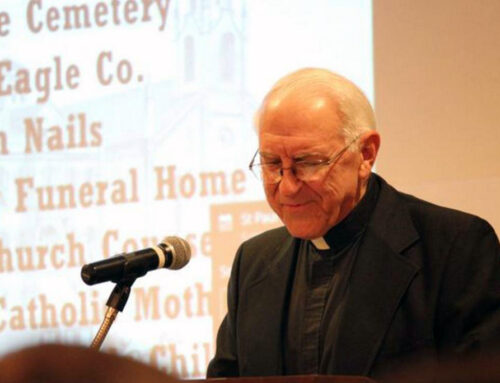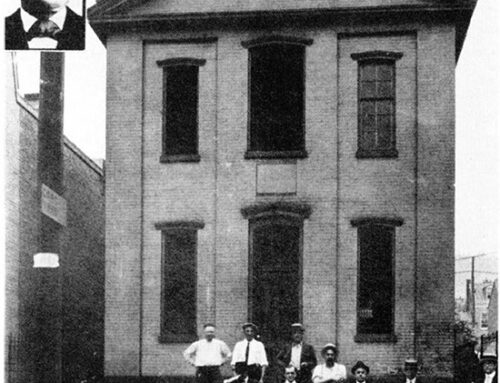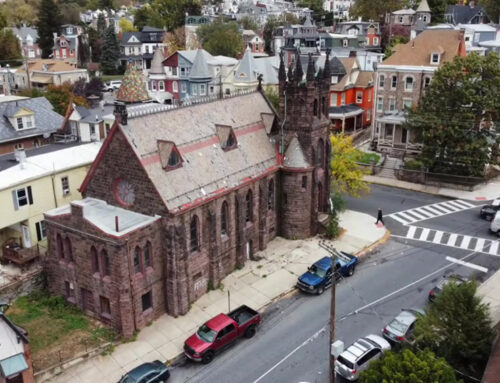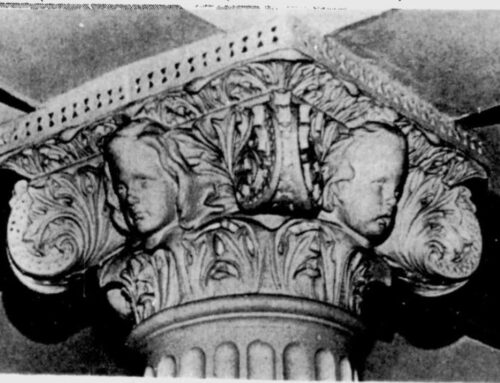By the dawn of the 20th century Reading was undergoing notable industrial expansion. The lure of jobs brought significant population growth to the area. Among the newcomers were many Catholics.
Monsignor George Bornemann of St. Paul’s Parish recommend to Edmund F. Prendergast, Archbishop of Philadelphia, that a new parish be establish west of the Schuylkill River.
In 1917, Archbishop Edmond Prendergast, acting on the recommendation of Monsignor George Bornemann of Saint Paul Parish, Reading, erected Sacred Heart of Jesus Parish to provide for the spiritual needs of those Catholics, primarily of German descent, living west of the Schuylkill River. Msgr. Bornemann, an astute man of the Church, purchased, in 1916, a plot of land at the southwest corner of Eighth and Hill avenues in Wyomissing (the current site of McDonald’s), directly across the street from the knitting mill complex which was a source of employment for many parishioners.

Below: Eighth and Hill avenues in Wyomissing (the current site of McDonald’s).

Father Charles Bornemann, the nephew of Msgr. Bornemann, was named the founding pastor of the new parish, which numbered 180 people. Father Bornemann celebrated the first Mass for the parish on 8 July 1917 in the Wyomissing town hall. The site afforded the parish a place for worship until the two-storied, brick, combination church-school was completed and put into service. Archbishop Dennis Dougherty of Philadelphia blessed the church-school building 7 July 1919. The church occupied the first floor, and a two-room school was on the second floor. To the rear of the classrooms, a small apartment provided living quarters for two Sisters of the Immaculate Heart of Mary, the first teachers for the school, which opened in September of 1919.
Below: Combination church and school building.


A rectory was purchased at 917 Franklin Street and served the needs of the parish until 1942. In the years that followed, the parish grew by leaps and bounds. Accurate parish records were not extant until 1943, but school records show steady growth: from 70 students in 1925 to 129 in 1930. Mindful of the growth of the parish and foreseeing that it would continue, Father Bornemann began to take steps to procure a new site for the parish. He purchased a home at 106 South Seventh Avenue to function as the convent for the expanding number of sisters.

With Father Bornemann’s transfer to Mahanoy City in 1928, the task to fulfill his vision would be handed over to Father John Wachter. In exchange for the Hill Avenue property, Father Wachter received $50,000 in cash and a parcel of land bounded by Lakeview Drive, Cherry Street, Seventh Avenue, and Franklin Street in West Reading. The new building to be erected on the corner of Franklin Street and Seventh Avenue was to be made of local granite and would be a combination church-school of unique and forward-thinking design. Cardinal Dougherty laid the cornerstone in 1929, and the new church was blessed on 4 May 1930 by Bishop Gerald O’Hara.

Below: Construction of combination church-school.

Below: Cornerstone laying for combination church-school.

Below: Combination church-school.

During the next decade, the parish continued to steadily grow. Its first assistant pastor arrived in 1934. By 1940, 175 students were enrolled in the school. A new rectory was purchased at 101-103 South Seventh Avenue and the convent was expanded. Within 25 years, the parish that was founded in Wyomissing had moved south of Penn Avenue and across Eighth Avenue into West Reading.
The year 1943 would prove to be significant in the life of Sacred Heart. Father Theodore Wagner was named the new pastor on 15 September. Within four years of his taking up the pastorate of Sacred Heart, Father Wagner’s parish became the mother-parish for Saint John Baptist de LaSalle Parish in Shillington. This daughter parish took all of southwest Reading up to and including Kenhorst, which had become a large segment of Sacred Heart’s membership. Nonetheless, the parish continued to grow following World War II.
The 1950’s saw the greatest development of the parish. By 1953, 1,000 more souls were added to the parish rolls, and the school was bursting at the seams. Now the parish faced its greatest challenge. With 3,000 parishioners and 460 school children, both church and school were overcrowded. Father Wagner, in 1956, undertook the daunting task of expanding the school and planning for a new church. On 24 July 1960, Msgr. Wagner broke ground for the new church at the corner of Franklin Street and Lakeview Drive. On Friday, 8 April 1962, Monsignor celebrated the first Mass in the new church with his beloved school children.
Below: Ground-breaking for new church.

Below: Completed church.


The mid-sixties proved to present new challenges to the parish. In June of 1965, the burgeoning parish once again gave birth to a daughter parish – Saint Ignatius of Loyola in Whitfield. Since 475 families were ceded to the new parish, the financial burden for the new church now rested on fewer shoulders.
Below: Saint Ignatius of Loyola in Whitfield.

Nevertheless Sacred Heart continued to thrive as a lively faith community. Programs for youth such as CCD, CYO, Boy Scouts, and Girl Scouts flourished. Graduates of the parish enrolled in the recently built Holy Name High School and quickly came to appreciate the excellent preparation they had received at Sacred Heart. Women of the parish were active in he Sacred Heart Society and men participated in the Holy Name Society and the Knights of Columbus.
Also, with the conclusion of Vatican II on 8 December 1965, the parish would have to adapt the sanctuary of its new church to accommodate for liturgical changes laid out by the Council Fathers. In both circumstances, under the guidance of Msgr. Wagner, the people of Sacred Heart rose to the occasion.
Sadly, Msgr. Wagner died 20 June 1979, and Father Alfred Ott became the fourth pastor of Sacred Heart. Working with parish leaders, a capital campaign was begun to finance a sorely needed Parish Center to provide space for parish activities. Two new buildings were planned: a center to include meeting rooms and a weekday chapel, and a new rectory with a separate office area. Determined to meet this new challenge, the people of Sacred Heart raised sufficient funds for construction of their new center. The buildings were constructed of granite taken from the same quarries used to build both the school and the church, making the parish facility a cohesive and impressive campus of which the people of the parish rightfully can be proud. The Parish Center, parish offices, and new rectory were completed and occupied by October of 1982.
Below: Parish Center.

Below: Rectory.

With much accomplished in three years, in 1987 Father Ott took on the remodeling of the interior of the church to better adapt the space for worship and current needs. The aisles were significantly widened; the sanctuary was given a new shape and elevation; new sanctuary furnishings were constructed of cherry wood to match the pews, and the confessionals were modified to accommodate penance face to face. Also, the large plaza and staircases leading to the church from the street were greatly reduced in size.
Below: Image Gallery – Remodeling of Church – Touch or Click Images to Enlarge.
In 1989, Father Ott was named the rector of the cathedral, and Father James Reichert, a former assistant during the time of Msgr. Wagner, was named pastor. After many years of use, the school showed signs of needed repair and updating. Following the celebration of the parish’s 75th anniversary in 1992, Father Reichert and his flock embarked on a capital campaign to help fund a complete school renovation, including an addition to the school itself, consisting of a new, expanded library on the first floor and a school-parish meeting room on the second floor, named the “IHM Room,” in honor of the Sisters of the Immaculate Heart of Mary who faithfully served the school and parish until 1992. Also, self-contained computer and science labs were part of the renovation. A loggia was built to connect the second floor of the school to the church. Granite from the original quarries was used once again for the addition and loggia.

In 2000, it was determined that the original aluminum tubing bell tower was so weakened that it was no longer possible to safely ring the three bells suspended in it. To replace it, a 65-foot granite campanile was erected on the corner of Lakeview Drive and Cherry Street. The design of the new bell tower is in keeping with the designs and materials used in all the parish buildings.
Below: New bell tower.

Following upon the heels of launching the diocesan capital campaign, Strengthening Our Future in Faith, Father Joseph DeSantis was named the sixth pastor of Sacred Heart in June 2003. The campaign included a 25 percent return to parishes of their collected pledges during the six-year campaign period. Father DeSantis designated all returns to be used for renovating and restoring the church.
Below: Father Joseph DeSantis.

A student of architecture, design, and liturgical arts, Father, together with a committee of seven parishioners, worked with Martin Rambusch of Rambusch Design Studios of New Jersey to guide them through the process of design and refurbishing. A guide consisting of “3R’s” was used in developing the project: Restoration, Renovation, and Repair. When the church was designed in 1960, both architect and pastor were strongly influenced by divergent modern architectures: Msgr. Wagner by what was called Euro-church design, and Wayne High, the architect, by American Frank Lloyd Wright’s organic architecture. The major task of the refurbishment was to preserve the integrity of the original design while making the overall plan well-balanced and visually pleasing, user-friendly, prayerful, and faithful to liturgy, ritual, and western Catholic, church architecture. The project took over 2¾ years from the first meeting to the consecration of the altar and church rededication on 17 December 2006 by Bishop Edward P. Cullen.
Below: Image Gallery – Restoration, Renovation, and Repair of Church – Touch or Click Images to Enlarge.
Below: Church rededication on 17 December 2006,





















Leave A Comment